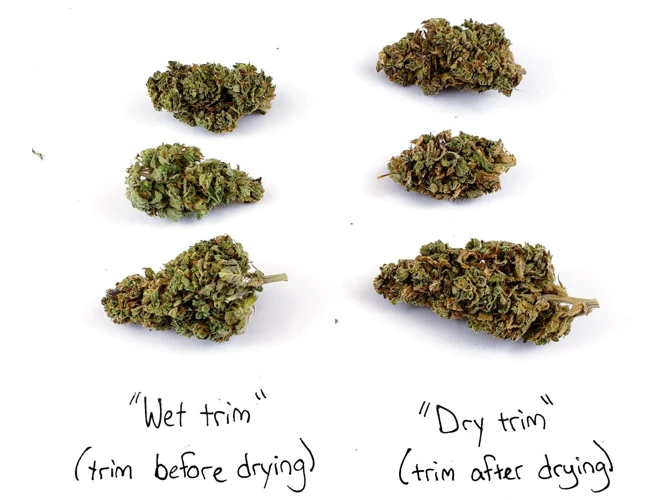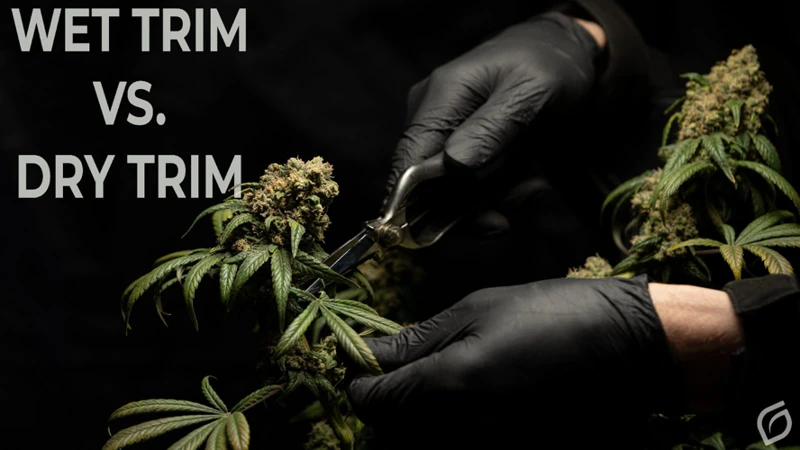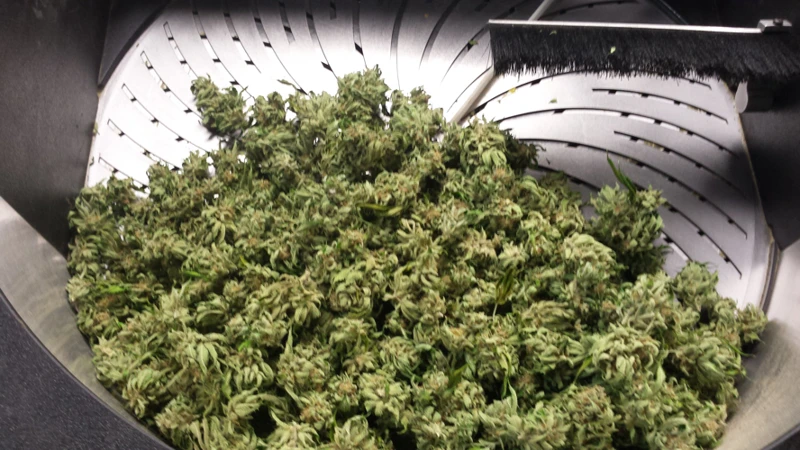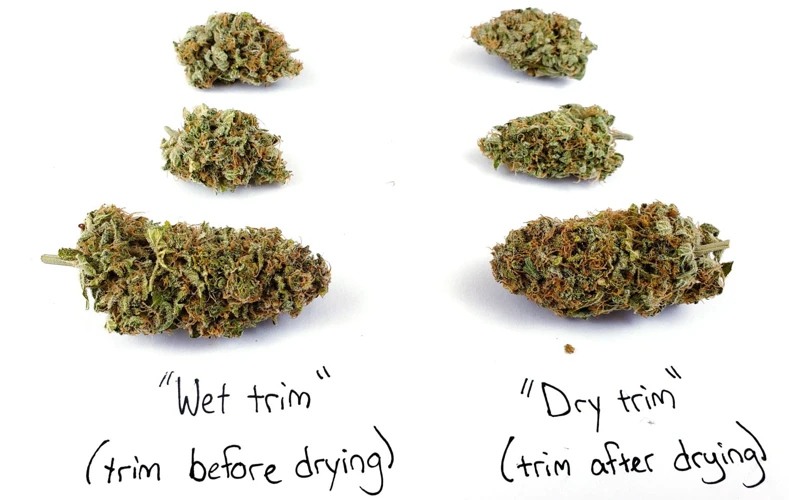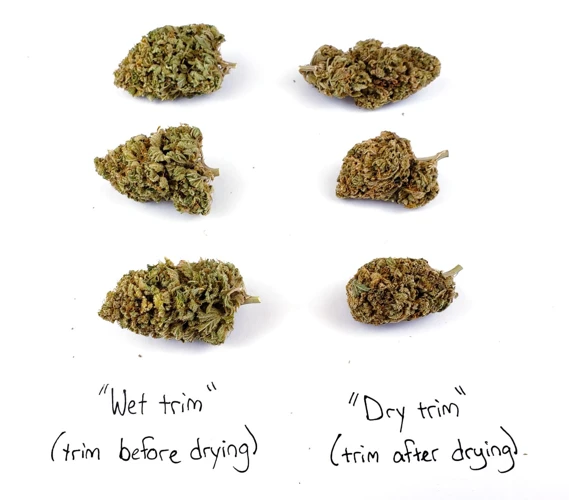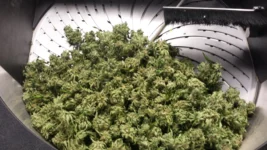
Wet vs Dry Trimming: What’s the Best Method for Your Cannabis Plants?
As any avid gardener knows, taking care of your plants is a labor of love. When it comes to harvesting, every detail matters to ensure the highest quality product. One important decision to make is whether to wet trim or dry trim your plants. Both methods have their pros and cons, and ultimately, the choice will depend on a range of factors including the size of your harvest, cost and time, and the desired quality of the final product. In this comprehensive guide, we will break down the differences between wet and dry trimming and provide step-by-step instructions for both methods to help you make the best decision for your plants.
What is Wet Trimming?
Contents
Trimming is an essential process for cannabis growers to remove unwanted leaves and improve the appearance and quality of the buds. Wet trimming is one of the most common methods used to trim cannabis plants, and it involves removing the leaves while the plant is still wet. This technique has its advantages and disadvantages, and it is important to consider them before deciding whether to use wet trimming for your cannabis harvest. Let’s take a closer look at what wet trimming entails and see if it might be the right method for you.
Pros of Wet Trimming
Wet trimming refers to trimming the plant immediately after harvesting. Here are some of the pros of wet trimming:
| Pros of Wet Trimming |
|---|
| Quicker Process: Wet trimming is a faster process than dry trimming because the leaves are moist and easier to cut. |
| Less Mess: By trimming the leaves when the plant is wet, the resin and trichomes are less likely to stick to everything, making cleaning up easier. |
| Less Chance of Mold: Wet trimming reduces the risk of mold formation because the plant’s moisture content is high, and mold prefers damp environments. |
| Better Control: Wet trimming allows a grower to have more control over the final product because they can see the shape of the buds and how they will turn out. |
Keep in mind that wet trimming can also have its cons. It’s essential to evaluate the pros and cons of both trimming methods and decide which one will work best for your situation.
Cons of Wet Trimming
One of the main disadvantages of wet trimming is that it can be quite messy and time-consuming. When you trim the buds while they still contain moisture, they tend to be stickier and more difficult to handle. This can make the trimming process more tedious and frustrating, as you’ll need to stop frequently to clean your tools and hands. Additionally, the excess moisture can cause the trichomes and resin to clump together and stick to your equipment, resulting in a loss of potency and flavor.
Another drawback of wet trimming is that it can result in a less visually appealing final product. Wet trimming can cause the leaves to become flattened and squished, making the buds appear less fluffy and full. Additionally, wet trimming can cause the outer layer of the buds to become damaged, which can lead to discoloration and a loss of potency.
Finally, wet trimming can be more difficult to do properly if you are using an automated machine. While there are many automated trimming machines available that are designed to handle wet buds, they can be more finicky to use and require more maintenance. Additionally, if the buds are too moist, they may cause the machine to jam or malfunction, which can be frustrating and time-consuming to fix.
While wet trimming can be a good option in certain situations, it’s important to carefully consider the potential drawbacks before deciding which trimming method is best for your needs.
When to Use Wet Trimming
Wet trimming should be used when:
- The cannabis plant is fresh and not fully cured. Wet trimming can help preserve the freshness of the plant and prevent mold and bacteria growth during the drying process.
- The grower is processing a large harvest and needs to trim quickly. Wet trimming can be faster than dry trimming since the leaves are still attached to the buds.
However, wet trimming may not be the best option in the following scenarios:
- The plant is too dry. Trimming wet may cause the leaves to become too moist and could lead to mold growth.
- The grower wants to preserve the terpenes and flavor of the plant. Wet trimming can potentially strip away some of the plant’s natural oils and aroma.
- The buds are delicate and prone to damage. Wet trimming can be rough on the buds and may cause excessive handling and potential loss of potency.
Ultimately, the decision of whether to wet or dry trim depends on the grower’s individual preferences and needs. It is important to weigh the pros and cons of each method before making a decision.
What is Dry Trimming?
When it comes to harvesting cannabis, dry trimming is another method used to remove the plant’s leaves. Unlike wet trimming, which is done shortly after harvest, dry trimming involves allowing the buds to dry for about a week before trimming them. The process involves using scissors to remove the leaves from the buds, and it can have both pros and cons. Let’s take a closer look at what to expect from dry trimming.
Pros of Dry Trimming
Dry trimming, also known as “slow trimming,” is a method of trimming where the harvested buds are dried first before trimming off the excess leaves. This method has gained popularity in recent years due to its advantages over wet trimming. Let’s take a look at some of the pros of dry trimming:
| Pros of Dry Trimming |
|---|
| Potent smell and flavor: One of the benefits of dry trimming is that it helps preserve the natural smell and flavor of the cannabis buds. This is because the excess leaves are removed after the buds have dried and cured. These leaves can contain terpenes, which are responsible for the aroma and taste of the cannabis plant. Dry trimming ensures that these terpenes are not lost during the trimming process. |
| Smoother burn: Dry trimming also ensures a smoother burn when smoking. This is because the excess leaves have been removed, leaving only the bud that will burn evenly. Wet trimming can leave excess moisture in the buds, causing uneven burning, which can affect the overall smoking experience. |
| Better storage: Dry trimming can also make storage easier. Since the buds have been dried, they can be stored in airtight containers without the risk of mold or mildew growth. Wet trimming can leave excess moisture in the buds, making them more susceptible to mold growth in storage. |
| Better for small batches: Dry trimming is a great option for small batch growers. Wet trimming requires a lot of space and equipment, making it less practical for small-scale operations. Dry trimming, on the other hand, can be done with basic equipment and a small space, making it a more feasible option for smaller growers. |
Dry trimming has several benefits over wet trimming, including better preservation of flavor and aroma, a smoother burn, easier storage, and practicality for small-scale operations. However, it is important to note that dry trimming can also have its disadvantages, which we will discuss in the following section. Ultimately, the decision to use dry trimming or wet trimming will depend on several factors, including the size of the harvest, cost and time, and the quality of the final product.
Cons of Dry Trimming
Dry trimming may not be the ideal method for all growers and there are some cons to consider before opting for it. These include:
| Cons | Explanation |
| Loss of Fragrance | Dry trimming can cause loss of terpenes and fragrances from the buds, making them less aromatic and flavorful compared to wet trimming. |
| Difficulties in Trimming | It can be harder to trim buds when they are dry compared to when they are wet. The buds become brittle and crumbly, and trimming can be time-consuming and labor-intensive. |
| Breakage | Dry trimming can result in the breaking of the delicate trichomes on the surface of the buds, which contain the plant’s essential oils and affect the potency and flavor of the final product. |
| Mold and Mildew | If the buds are not dried carefully, they can be susceptible to mold and mildew growth which can compromise the potency and safety of the final product. |
It is important for growers to weigh the pros and cons of both wet and dry trimming before deciding which method to use for their harvest.
When to Use Dry Trimming
Dry trimming is ideal for growers who have a larger harvest and want to save time and money. Here are some instances where using dry trimming may be the right choice:
- Dry weather conditions: If you’re experiencing dry weather conditions, then dry trimming would be the better option. This is because dry conditions reduce the risk of mold and mildew growth when the buds are left hanging to dry without leaves.
- Larger harvest: If you have a larger harvest, it would be more efficient to use dry trimming as it allows you to trim the buds quickly and move them into the drying phase without needing to stop and clean your trimming tools frequently.
- Less delicate strains: Dry trimming is also suitable for strains that are less delicate and have sturdier buds, making them less prone to crumble or break during the trimming process.
- Cost-effective: Dry trimming is also cost-effective as it eliminates the need for a trimming machine and reduces the number of required tools.
Remember that choosing between wet and dry trimming depends on various factors, and it is essential to consider the quality of the final product, cost, time, and the size of the harvest before making a decision.
Factors to Consider
When deciding between wet and dry trimming, there are several significant factors to keep in mind that will ultimately determine which method is best for your particular situation. It is important to weigh the pros and cons of each method in the context of the size of your harvest, the cost and time required, and the quality of the final product. By considering these factors, you can make an informed decision about whether to use the wet or dry trimming method for your cannabis trimming needs. Let’s take a closer look at each of these factors in turn.
Size of Harvest
When deciding between wet and dry trimming, the size of the harvest can be a crucial factor to consider. Large harvests may require a faster trimming method, and wet trimming is usually faster than dry. Wet trimming can help to process a lot of plants quickly while keeping the buds fresh and fragrant. However, a small harvest can benefit from a more hands-on approach, with dry trimming allowing for a more delicate trim that preserves the final product’s quality.
It is essential to assess the size of the harvest before deciding which trimming method to use. With a large harvest, wet trimming can be efficient because it is a faster process that can handle many plants in a shorter period. Also, wet trimming leads to fewer trichomes getting lost, which is what happens when bud is dried first. If time is a concern, wet trimming can be an effective way to get the job done quickly, especially when trimming machinery is available.
When dealing with a smaller harvest, dry trimming can be a more gentle approach that provides a better quality trim. Dry trimming can allow for closer attention to each bud, ensuring that each one is trimmed correctly and shows off its unique characteristics. The small size of the batch allows for a more artisan approach, and the buds will be more appealing to connoisseurs. The slower process allows for a more hands-on approach, which can result in a more precise cut.
In conclusion, the size of the harvest is an important consideration when selecting which trimming method to use. Wet trimming is more suitable for a large harvest when time is a critical factor, while dry trimming is better when quality is the primary concern. It is essential to choose a method that provides the desired result and meets the needs of the grower.
Cost and Time
When it comes to cost and time, there are several factors to consider before deciding which trimming method is the right one for you. It’s important to think about the size of your harvest, the tools you’ll need, and the overall quality of the final product.
| Factor | Wet Trimming | Dry Trimming |
|---|---|---|
| Cost of Tools | Higher cost due to need for additional equipment such as trimming scissors and gloves. | Lower cost since minimal tools are required. |
| Time Required | Quicker process since the wet leaves are easier to trim, but the buds must be dried for a longer period of time. | Longer process since the dry leaves are brittle and require more precision, but buds can be cured and packaged immediately after trimming. |
| Quality of Final Product | Potentially lower quality if not done carefully, as the wet leaves can get stuck to each other and dampness can promote mold growth. | Potentially higher quality if done correctly, as the dry trimming process can preserve trichomes and create a better flavor profile. |
If you have a small harvest and are on a tight budget, dry trimming might be the best option for you. However, if you have a larger yield and the necessary equipment, wet trimming could be a quicker and easier process. Ultimately, the decision on which method to utilize should be made based on your individual needs and preferences.
Quality of Final Product
The quality of the final product is a crucial consideration when deciding on the trimming method to use. Here are some factors to consider when it comes to the quality of the final product:
- Aroma: The aroma of the final product is one of the most important factors to bud enthusiasts. Many believe that wet trimming can diminish the aroma due to the loss of volatile terpenes during the trimming process. On the other hand, dry trimming can help preserve the terpenes leading to a stronger aroma in the final product.
- Appearance: Both wet and dry trimming can produce visually pleasing results. However, dry trimming can create a more “rustic” look, as the sugar leaves remain intact, while wet trimming can result in a cleaner and more manicured look, giving the buds a “popcorn” shape.
- Flavor: Just like aroma, flavor is closely related to terpenes. While wet trimming can lead to a loss of terpenes, there is a belief among some growers that dry trimming can lead to a harsher taste due to oxidization. However, this may be mitigated by proper storage techniques.
- Effect: The effect or potency of the final product usually depends on genetics and growing conditions. However, some growers believe that dry trimming can lead to a more potent product because of the increased preservation of the trichomes.
The quality of the final product can depend on a variety of factors, including genetics, drying and curing techniques, and personal preferences. It is important to consider the pros and cons of wet and dry trimming and choose a method that you think will produce the best results for your crop.
How to Wet Trim
Now that we have discussed the pros and cons of wet trimming and when to use it, let’s dive into the process of wet trimming your cannabis plants. Wet trimming can be a bit more challenging than dry trimming, but with the right tools and techniques, you can achieve a higher quality final product. In this section, we will provide a detailed guide on how to wet trim your cannabis plants, step-by-step. Make sure to read through the entire process before starting and take your time to ensure a successful trim.
List of Tools Needed
When it comes to trimming cannabis, having the right tools is essential for achieving a clean and precise result. Here are the tools you’ll need for both wet and dry trimming:
For Wet Trimming:
- Trimming scissors: Look for scissors with blades that are sharp and precise. They should be comfortable to hold and use for extended periods of time.
- Rubber gloves: Wet trimming can be messy, so wearing rubber gloves will protect your hands and also prevent trichomes from sticking to your skin.
- Pruning shears: These can be useful for removing larger leaves before getting started with the scissors.
- Buckets or containers: For wet trimming, you’ll need containers to keep the trimmed buds in as you work.
- Clean water: Having a source of clean water nearby will help you keep your tools and work area clean during the process.
For Dry Trimming:
- Trimming scissors: Just like with wet trimming, you’ll need a good pair of sharp trimming scissors. They should be comfortable to hold and use for extended periods of time.
- Buckets or containers: For dry trimming, you’ll need to have containers to catch trimmings, as well as a separate container for the trimmed buds.
- Drying rack: After trimming, you’ll want to dry your buds using a drying rack that allows for good airflow.
- Pruning shears: Pruning shears can also be useful for dry trimming, particularly for larger leaves that can be difficult to remove with scissors.
- Protective eyewear: When dry trimming, tiny plant particles and trichomes can become airborne, so wearing protective eyewear can help keep your eyes safe.
Having these tools ready and easily accessible will make the trimming process more efficient and enjoyable, and will help you achieve the best possible end result.
Step-by-Step Instructions
For both wet and dry trimming, there are specific steps to follow in order to achieve the best results possible. Here are step-by-step instructions for each method:
Wet Trimming:
- Harvest your plants and remove all of the large fan leaves, leaving only the buds and smaller leaves.
- Prepare a large container filled with ice-cold water.
- Take each branch and submerge it in the water, using gentle agitation to remove any remaining leaves.
- Once the excess leaves have been removed, shake off any excess water and hang the branches to dry.
- Allow the branches to dry for a few days until they reach the desired moisture level.
- Trim any remaining leaves using sharp scissors or a trimmer.
- Cure the buds as usual.
Dry Trimming:
- Hang your harvested plants in a dry, cool place with good airflow.
- Once the plants are dry, remove all of the large fan leaves, leaving only the buds and smaller leaves.
- Using sharp scissors or a trimmer, carefully trim away any remaining leaves from the buds.
- Cure the buds as usual.
It is important to note that regardless of the trimming method chosen, it is crucial to handle the buds with care in order to preserve their potency and flavor. Remember to be gentle and patient throughout the trimming process to ensure the highest quality final product.
How to Dry Trim
Once your cannabis plants have been harvested, you will need to remove the leaves and stems in a process known as trimming. Dry trimming is an alternative to wet trimming that involves letting the plant dry for several days before removing the leaves and stems. This method has its own advantages and disadvantages, and requires a different set of tools and techniques compared to wet trimming. In this section, we will take a closer look at how to dry trim your cannabis harvest for a high-quality final product.
List of Tools Needed
To successfully trim cannabis, you need certain tools and equipment. Here are the tools that are needed for both wet and dry trimming:
- Trimmers: Trimmers are essential for both wet and dry trimming. While there are various trimmer models available in the market, handheld trimmers are a popular option for small-scale operations. Motorized trimmers are a great option for larger harvests.
- Pruning Shears: Pruning shears are ideal for trimming dried buds. They help to snip away any additional leaves and provide precision trimming.
- Scissors: Scissors are also used for precision trimming. They can be used to defoliate the plant before harvesting.
- Gloves: It is essential to wear gloves while trimming. Not only does it protect your hands, but it also helps in maintaining the quality of the buds.
- Large Trays: Large trays are necessary for wet trimming. They help in keeping the space neat and tidy, and also prevent the buds from sticking together.
- Buckets: Buckets are also needed for the wet-trimming process to ensure that the trimmed buds remain moist and fresh.
- Microscope: A microscope is an optional but useful tool. It helps in identifying when the trichomes are ready for harvesting.
- Clean Working Surface: It is essential to have a clean working surface to ensure that the harvested buds don’t get contaminated.
Having these tools ready before the start of the trimming process will ensure that the process goes smoothly, and the quality of the buds is not compromised.
Step-by-Step Instructions
Sure! Here are step-by-step instructions for both wet trimming and dry trimming:
Wet Trimming:
- Prepare your tools according to the list provided in the previous section. Make sure everything is clean and ready to go.
- Once you have harvested your plants, remove any large fan leaves by hand. This will give you better access to the smaller leaves that need to be trimmed.
- Using a pair of sharp scissors or pruning shears, trim off each individual bud at its base. Cut away any excess stem or leaf material, leaving only the bud itself.
- Place the trimmed buds in a container or on a drying rack to dry. Make sure that they are not touching each other and that there is good air circulation around them.
- Continue the trimming process until all of your buds have been trimmed.
- Clean up your work area and your tools. Dispose of any plant material properly.
- Wait for your buds to dry before moving on to the curing process.
Dry Trimming:
- Again, prepare your tools according to the list provided earlier. Make sure everything is clean and ready to go.
- Harvest your plants and hang them up to dry in a cool, dark, dry place with good air circulation. It’s important to let the plants dry completely before trimming.
- Once your plants are dry, remove the large fan leaves by hand. This will give you better access to the smaller leaves that need to be trimmed.
- Using a pair of sharp scissors or pruning shears, trim off each individual bud. Cut away any excess stem or leaf material, leaving only the bud itself.
- Place the trimmed buds in a container or on a drying rack to dry further. Make sure that they are not touching each other and that there is good air circulation around them.
- Continue the trimming process until all of your buds have been trimmed.
- Clean up your work area and your tools. Dispose of any plant material properly.
- Wait for your buds to dry completely before moving on to the curing process.
Remember, when trimming your buds, it’s important to be gentle and patient. Rushing through the process can damage the buds and negatively impact the final product. Follow these step-by-step instructions for a successful trim.
Tips for a Successful Trim
As the trimming process can make or break the quality of your final product, it’s crucial to follow a few tips and tricks to ensure a successful trim. From preparing your tools and workspace to being gentle and patient with the plants, there are a number of things you can do to achieve the best results. In this section, we will outline some essential tips for a successful trim to help you get the most out of your cannabis harvest.
Preparation is Key
One of the most crucial aspects of successful trimming, be it wet or dry, is preparation. Proper preparation is key to a successful trim, and can help prevent mistakes and ensure the final product is of the highest quality. Here are some important steps to take to prepare for a successful trim:
Clean Tools: Before starting the trimming process, it’s important to ensure that all the tools you will be using are clean and free of debris. This includes trimming shears, scissors, and any other equipment you may need. Using dirty tools can introduce harmful bacteria that can damage the final product and affect its quality.
Clean Environment: It’s equally important to clean the work environment thoroughly before beginning the trimming process. This includes the work surface, the trimming area, and any other surfaces or tools you will be using. A clean environment helps to reduce the risk of contamination and ensures that the final product is high quality.
Proper Lighting: Proper lighting is imperative when trimming cannabis, as it can help you ensure that you’re trimming the right parts of the plant and that you’re not leaving behind any unwanted leaves or stems. Investing in proper lighting can go a long way in ensuring a successful trim.
Comfortable Seating: Trimming can be a time-consuming process, and it’s important to be comfortable throughout the process. Investing in comfortable seating can help reduce the risk of cramps, back pain or other discomforts, which can reduce the quality of the final product.
Proper Harvest Timing: Finally, proper harvest timing is crucial to the success of the trimming process. The timing of the harvest can affect the final quality of the flower, so be sure to research the optimal time to harvest, and plan accordingly. It’s important to harvest at just the right time to get the best results from the trimming process.
By properly preparing before starting the trimming process, you can help ensure that the final product is of the highest quality. Taking the time to clean tools and the work environment, investing in proper lighting and comfortable seating, and timing the harvest properly, are all important steps in achieving a successful trim.
Be Gentle and Patient
When it comes to trimming, it is important to remember to be gentle and patient. Rushing this process can lead to a lower quality final product. Here are some tips to keep in mind:
- Take breaks: Trimming can be a tedious and repetitive task, and it’s important to give yourself and your hands a break. Take a few minutes every hour to stretch and rest your hands.
- Use the right tools: Using the right scissors and equipment can make the process smoother and easier on your hands. Make sure your scissors are sharp and comfortable to hold.
- Slow and steady: Take your time when trimming to ensure you are getting the best quality results. Rushing can lead to mistakes and lower quality final product.
- Pay attention: It’s important to focus on each individual bud or leaf that you are trimming. Pay attention to the shape and structure of each one to ensure you are getting the best possible result.
- Be gentle: While trimming, it’s important to be gentle with the buds or leaves. Avoid squeezing or handling them too roughly, as this can damage the structure and affect the overall appearance and quality of the final product.
- Don’t over-trim: While it’s important to get rid of excess leaves and stems to improve the appearance of the buds, it’s also important to not over-trim them. Removing too much can affect the flavor and potency of the final product.
Remember, trimming can be a time-consuming and repetitive task, but being patient and gentle can lead to a higher quality final product. Take your time, use the right tools, and pay attention to each individual bud or leaf to ensure the best possible result.
Focus on Quality
One of the most important aspects of trimming, whether wet or dry, is maintaining or improving the quality of the final product. Here are some tips to help you focus on quality during the trimming process:
- Inspect the buds carefully: Before you begin trimming, take some time to thoroughly examine the buds. Look for any signs of damage or disease, as well as any excess leaves that need to be trimmed. This will help you identify problem areas and avoid damaging the buds during trimming.
- Use sharp tools: Having sharp trimming tools is essential for maintaining the quality of the buds. Dull scissors or shears can crush the buds or tear away more than just the leaves, which can damage the trichomes and affect the potency and flavor of the final product.
- Take your time: Trimming can be a tedious process, but it’s important to be patient and take your time. Rushing can lead to sloppy cuts, which can damage the buds and reduce their overall quality.
- Be mindful of the environment: When trimming, it’s important to keep the environment clean and free of dust and debris. Make sure you’re working in a well-lit, well-ventilated space to avoid any unwanted contaminants from getting into the buds.
- Store trimmed buds properly: After you’ve finished trimming, store the buds in an airtight container and away from light and heat. This will help preserve their flavor and potency over time.
By focusing on quality during the trimming process, you can ensure that you end up with a final product that is not only visually appealing, but also potent and flavorful.
Conclusion
In conclusion, both wet and dry trimming methods have their own advantages and disadvantages. What method you choose mainly depends on personal preferences, size of the harvest, available time and cost, and the quality of the final product.
Wet trimming is recommended for those who want to finish the trimming process quickly, as it takes less time than dry trimming. Wet trimming also minimizes the chance of mold growth and allows for easier handling of the buds. However, wet trimming can cause the loss of terpenes and other compounds that give cannabis its flavor and aroma. Therefore, cannabis enthusiasts who are particular about preserving the full flavor and aroma usually prefer dry trimming to wet trimming. Wet trimming is also best for those who have a large harvest and want to process it quickly.
Dry trimming, on the other hand, preserves the terpenes and other aroma compounds of the cannabis plant, making it an ideal option for those who want to achieve the best quality possible. Dry trimming also allows the buds to be cured slowly without losing potency. However, it is a more time-consuming process and can take several weeks to complete. Dry trimming can also increase the likelihood of mold growth, especially if the humidity is not properly controlled during the curing process. For those who have a smaller harvest and want to take the time to achieve the best possible quality, dry trimming is the recommended method.
Regardless of the method chosen, it is important to prepare well and have the necessary tools on hand. Remember to be gentle and patient during the trimming process, and to focus on the quality of the final product. Whether you choose wet or dry trimming, the goal is the same: to produce the best quality cannabis buds possible.
Frequently Asked Questions
Can wet trimming affect the potency of my harvest?
Wet trimming does not affect the potency of your harvest. The potency is determined by the strain genetics and the growing conditions, not the trimming method.
Is dry trimming more time-consuming than wet trimming?
Yes, dry trimming can take longer than wet trimming due to the increased number of buds to trim and the need for extra care to avoid damaging the delicate trichomes.
Can dry trimming result in a smoother smoke?
Yes, dry trimming can result in a smoother smoke because it allows the buds to dry more slowly, enabling the terpenes to fully develop and create a smoother taste and aroma.
Is wet trimming more cost-effective compared to dry trimming?
Wet trimming can be more cost-effective than dry trimming because it is faster and requires less specialized equipment. However, the quality of the final product may be affected.
Can both wet and dry trimming methods be used on all strains?
Yes, both wet and dry trimming methods can be used on all strains. However, some strains may require one method over the other depending on their size and density.
How can I prevent mold growth during the wet trimming process?
To prevent mold growth during the wet trimming process, make sure to keep the humidity levels in the trimming area low, use clean and sterilized tools, and avoid overcrowding the buds.
Can dry trimming help preserve more trichomes than wet trimming?
Yes, dry trimming can help preserve more trichomes than wet trimming because the buds are allowed to dry slowly, preventing trichomes from being knocked off during the trimming process.
What is the best time to trim my buds?
The best time to trim your buds is after they have completed the drying process. Wet trimming should be done immediately after harvesting the plants.
How can I improve the quality of my final product during trimming?
To improve the quality of your final product during trimming, make sure to handle the buds gently, work in a clean and organized area, and use sharp and clean tools.
Can I use a machine to trim my buds instead of doing it by hand?
Yes, you can use a machine to trim your buds instead of doing it by hand. However, using a machine can result in a lower quality product and may damage the trichomes and buds.

